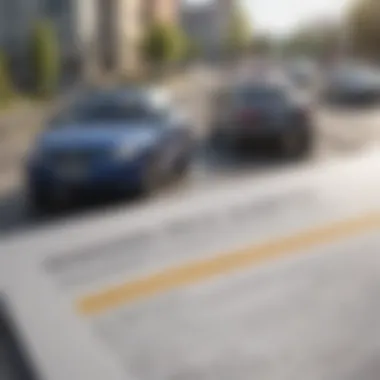Can You Get Gap Insurance Later? A Comprehensive Guide


Intro
When you’ve just driven off the lot, the last thing on your mind might be that insurance gap. However, as life often plays out, unexpected situations can stir the pot, leaving many drivers wondering if it's too late to secure a financial safety net. Enter gap insurance: an option that feels like a warm blanket on a cold night for those who find themselves in tricky situations.
In its essence, gap insurance bridges the financial divide between what you owe on your vehicle and its actual cash value if it suffers a total loss. It’s particularly useful for those who have financed their vehicles, where the loan amount can heavily outpace the vehicle's depreciation post-purchase. But can you really get it after that initial purchase? This piece digs deep into that question and the nuances surrounding it.
Prepared to scour the intricacies of gap insurance? You’ll discover frameworks of key terms, learn when it might be appropriate to seek it out after the fact, and gain insights that empower you to consider gap insurance as a prudent element in your wider financial strategy. This guide aims to unveil the layers, making it clear whether this insurance fits snugly into your financial plan.
Understanding Gap Insurance
Gap insurance plays a vital role in the automotive insurance landscape, particularly for those who find themselves on the hook for outstanding loan amounts after their vehicle is totalled. This section delves into what gap insurance really means and why it might be something to think about – especially for new car buyers who might not have encountered it before. Understanding this coverage is crucial for anyone who is serious about protecting their financial interests.
Defining Gap Insurance
Gap insurance, in its simplest terms, is a supplemental policy designed to cover the difference between what you owe on your vehicle and its current market value at the time of a total loss. Imagine you drive a shiny new car off the lot, only for it to be totaled a few months down the line. If you owe significantly more than what the car is worth, that debt doesn’t magically disappear. In essence, gap insurance bridges this financial gap, making sure that both your investment and financial future remain intact.
If you don’t have it, you’re left facing a considerable out-of-pocket expense, which nobody wants to deal with.
How Gap Insurance Works
So how does this insurance policy fit into the bigger picture? When you purchase or lease a vehicle, it begins to depreciate the moment it’s driven off the sales floor. As a result, it’s common for a borrower to owe more money on their car than it’s worth very quickly.
Here’s how it works in a nutshell:
- When your vehicle is deemed a total loss due to accident, theft, or other incidents, your standard insurance will pay out the vehicle’s current market value.
- If that amount is less than the remaining loan balance, gap insurance steps in to cover the difference.
- Essentially, you can rest easy knowing you won’t be stuck in a financial pickle should something unfortunate happen to your car.
The Importance of Gap Insurance
Why is this coverage so essential? There are several factors to consider, especially for those who’ve recently purchased a vehicle.
- Protection Against depreciation: Cars lose value fast – it’s part and parcel of the automotive world. Toyota Corollas, for instance, depreciate significantly just within the first few months.
- Peace of Mind: With gap insurance in your corner, you can breathe easier knowing that should the worst occur, you have a safety net.
- For Leased Vehicles: Many leasing companies require gap insurance. If that’s your situation, not having it could lead to problems.
- Financial Strategy: Making informed decisions about your financial protections not only safeguards your current assets but also sets up a stronger foundation for your future investments.
"Adequate insurance coverage is not just about compliance; it's about financial prudence."
In summary, understanding gap insurance isn't merely academic; it’s about safeguarding economic well-being in a world where vehicle value can fluctuate like the stock market. As you consider the remaining sections of this guide, keep these fundamental aspects of gap insurance in mind. They play a crucial role in whether this coverage should be on your radar after the purchase of your vehicle.
Acquiring Gap Insurance After the Purchase
Acquiring gap insurance after purchasing a vehicle is a critical aspect that many might overlook in the realm of automotive finance. This guidance aims to illuminate when and why someone should consider this type of coverage post-purchase. While the primary goal of gap insurance is to cover the difference between what you owe on your car and its current market value, awareness of your options after the vehicle has been bought is equally important.


Understanding how the dynamics of depreciation and your specific financial situation come into play can make all the difference in avoiding potential losses. Here, we will uncover various circumstances where securing gap insurance later becomes not just beneficial but sometimes necessary.
Evaluating the Need for Gap Insurance
Determining the need for gap insurance can be a pivotal factor in protecting one’s financial investments when owning a vehicle. This section aims to dissect various aspects that contribute to this evaluation, providing insights into how individuals can make informed choices regarding acquiring this type of coverage.
Assessing Your Vehicle’s Value
To start off, understanding your vehicle’s current market value is critical. A simple online search or a visit to sites like Kelley Blue Book can give you a ballpark figure. However, remember that the price listed does not reflect the amount you might receive from your insurer after an accident. It’s important to dig deeper than just surface values. Factors such as the vehicle's condition, mileage, and any modifications can greatly influence its worth.
Moreover, knowing what your car is selling for can also help you in negotiations for gap insurance. If your vehicle depreciates faster than the regular norm, it might increase the urgency to acquire gap insurance, especially considering the potential financial loss that could occur if the vehicle is totaled.
Understanding Depreciation
Depreciation is like the sneaky thief that steals value from your vehicle almost as soon as you drive it off the lot. On average, a new car can lose somewhere between 20% to 30% of its value in the first year. That’s substantial! In simpler terms, if you buy a car for $30,000, it may only be worth around $21,000 after just one year.
Understanding these numbers is key when considering gap insurance. If you financed your vehicle with a loan, there’s a good chance that what you owe could exceed what your vehicle is worth, particularly in those first few years. Gap insurance fills that gap — it compensates for the difference between what you owe on your car and its depreciated value after a total loss.
Personal Financial Situation Assessment
No two financial situations are the same. It’s imperative to take a long, hard look at your own financial landscape before deciding on gap insurance. Ask yourself questions like:
- What is my current monthly budget like?
- How much do I currently owe on my vehicle?
- What is the potential risk of my car being declared a total loss?
Evaluating your financial stability can lead to clarity on whether gap insurance would be a wise investment. If you find yourself in a position where car accidents occur frequently or you’re driving a particularly high-risk vehicle, having gap insurance may provide an additional layer of comfort.
Essentially, weigh the costs against the benefits. If financially feasible, purchasing gap insurance may prove advantageous.
"Assessing your vehicle’s value, understanding depreciation, and evaluating your financial situation are all critical elements in deciding the necessity of gap insurance. Make informed choices to protect your investments."
Financial Implications of Gap Insurance
The decision to pursue gap insurance is not just a matter of acquiring another policy; it has real financial implications. Understanding these implications can significantly impact your future financial stability, especially if you've recently acquired a vehicle. This section of the guide digs into the costs associated with gap insurance, the potential savings it may offer, and the long-term financial perspective that supports its value.
Cost Considerations
When looking at gap insurance, one of the first things to consider is the cost. On average, the premium for this insurance can range from $20 to $50 per year, depending on various factors like the vehicle's make, model, and market preferences. It's vital to take a close look at your budget and decide how much you're willing to allocate.
A few cost considerations include:
- Policy Type: Gap insurance can be purchased through an auto dealer or insurance company. Dealer prices might be double those of insurance agencies, so it pays to shop around a bit.
- Market Value of Your Vehicle: A more expensive car typically comes with higher premiums. A vehicle that depreciates quickly might also affect the pricing.
- Personal Risk Assessment: Your own driving history and the likelihood of accidents or total loss can affect your rates.


When it comes to finances, weighing these costs might feel like a daunting task, yet it’s essential for making sound financial decisions. SETTING A DETAILED BUDGET that outlines car expenses can help clarify whether adding gap insurance is a sensible move.
Potential Savings from Gap Insurance
The financial world can be unpredictable, and owning a car does not come without its risks. The primary advantage of gap insurance is its potential for significant savings. In the event of a total loss, gap insurance could raise the amount you receive from your insurer, covering the difference between what you'll get from your auto insurance and the remaining balance on your loan.
Here's how potential savings can stack up:
- If you bought a vehicle for $30,000 and, after an accident, your insurance only values it at $15,000, gap insurance could cover the remaining $15,000 that you still owe on that car loan.
- Additionally, many gap insurance policies will cover your deductible, which means even more savings in a pinch.
- In some cases, it could also help preserve your overall financial health, preventing unplanned debts that could lead to long-term struggles.
By offering this protection, gap insurance serves as a financial safety net, shielding you from the risk and helping keep your bank account stable.
Long-term Financial Impact
While the immediate costs and savings attached to gap insurance are compelling, it is equally important to reflect on the long-term impact. Investments in gap insurance should be seen as part of a broader financial strategy designed to promote stability and security. Here are a few elements to keep in mind:
- Debt Management: Having gap insurance can alleviate the anxiety linked to your vehicle loans, allowing you to manage other financial facets more efficiently.
- Credit Score Protection: Avoiding debt due to an unexpected loss can also safeguard your credit rating. If you're unable to pay off what’s owed on a vehicle due to insufficient insurance payouts, your credit might take a hit, affecting future borrowing costs.
- Personal Peace of Mind: With the right coverage, driving becomes less about worrying over potential losses and more about the journey ahead. This peace of mind can play a subtle yet crucial role in your financial well-being.
Steps to Acquiring Gap Insurance Later
Understanding how to acquire gap insurance after purchasing a vehicle is vital for any car owner. As financial landscapes shift, vehicles can depreciate swiftly, leaving owners susceptible to losses that standard coverage does not mitigate. Knowing the steps involved in obtaining gap insurance later reveals your choices and empowers you to safeguard your investments. A solid grasp of this process aids in navigating through various options, ensuring that you can opt for the best coverage tailored to your needs and financial situation.
Researching Available Options
When looking to get gap insurance after you've purchased your vehicle, the first step is researching available options. A plethora of insurance providers offer gap coverage, but they do so under different terms. This stage involves dissecting various policies to find one that aligns with your needs. Consider the following aspects:
- Coverage specifics: What exactly does the policy cover? Be clear about aspects like deductibles or any extra fees that might apply.
- Premium differences: Prices can vary widely among insurers. Obtaining quotes is essential in spotting the best deal.
- Reputation of the insurer: Online reviews and industry ratings can provide insights into their service quality and how they handle claims, which is paramount when you need assistance.
- Flexibility of coverage: Some policies allow adjustments as your circumstance changes. Having options can often save you stress down the road.
In essence, a well-researched decision often results in smarter financial management later on.
Consulting with Insurance Professionals
After gathering information on various options, consulting with insurance professionals becomes the next logical step. Engaging experts can provide invaluable clarity in a complex landscape. Here’s why seeking professional advice matters:
- Tailored recommendations: Insurance agents or brokers can analyze your specific needs, personal situation, and vehicle type, suggesting the most suitable coverage.
- Clarification of terms: Transactions often come with specific jargon that might confuse many. Professionals break down all the fluff, helping you grasp every detail.
- Coverage for existing loans: If you have a loan on your vehicle, understanding how existing loan balances play into coverage is essential, and professionals can guide you here.
- Explaining the application process: They can walk you through how to apply while ensuring you avoid potential pitfalls that could delay your coverage.
Consulting these professionals gives you an edge, helping you make an informed choice that aligns your gap insurance with broader financial objectives.
Submitting Applications and Agreements


Once you've followed the previous steps, it’s time to focus on submitting applications and agreements. This stage might seem straightforward but can be quite significant:
- Accurate information: Fill out all required information honestly and completely. Incomplete applications can lead to delays or even rejection.
- Document verification: Most insurers will request copies of vehicle-related documents and possibly your existing insurance policy. Have these on hand to streamline the process.
- Understanding the fine print: Before signing any agreement, read the policy carefully. Ensure all terms meet your expectations and there are no hidden surprises.
- Tracking application status: After submitting your application, maintain contact with the insurer. Knowing the status will help you avoid any unforeseen complications.
By tackling these steps with diligence and awareness, the road to acquiring gap insurance becomes clearer, ensuring you make decisions that fortify your financial standing.
Challenges in Acquiring Gap Insurance Later
Acquiring gap insurance after you've already made the leap to purchase a vehicle presents its own set of hurdles. It's crucial to understand these challenges thoroughly as they might sense one's reasoning toward making that financial safety net a priority post-purchase. While gap insurance is designed to cover the difference between what you owe on your car and its actual value in case of a total loss, the path to obtaining it later can come with not just red tape but also limitations that may need addressing ahead of time.
Insurer Policies on Late Acquisition
Different insurance companies have varying stances on the matter of late acquisition of gap insurance, and many times, those policies can feel more like a hurdle than a helping hand. Some insurers might offer this as an option, while others might flat out refuse. This variance means that consumers need to do their homework rigorously. The timing of when you seek gap insurance can play a significant role in your success. For instance, if you're approaching the end of your financing term, some insurers may deny the application based on their policies that generally aim to limit risk. Furthermore, they may take into account the depreciation rate of your vehicle. A car that’s already lost significant value might find fewer opportunities for gap insurance.
Limitations in Coverage Options
Even if a buyer gets their foot in the door for securing gap insurance after purchasing their vehicle, the specific coverage options might dwindle. Often, coverage will have stricter limits compared to policies taken at the time of purchase. Insurers might exclude particular situations, such as damage caused by non-collision incidents or total loss from theft if the policy is applied for later. This narrowing of coverage makes it essential for buyers to lay out clear terms and limitations at the outset. Consumers should know what’s on the table and what isn’t — if they find that their insurance policy isn't robust enough to cover all potential scenarios, this could lead to significant out-of-pocket expenses after a loss.
Understanding Exclusions and Limitations
Much like knowing the ins and outs of any financial product, understanding the exclusions and limitations of late-acquired gap insurance can be the linchpin in making an informed decision. For example, if you obtain gap insurance a year after purchase, it’s likely to have more stipulations compared to the same policy secured at the time of the initial purchase. Certain scenarios that might seem plausible to you, such as business usage of a vehicle or driving in specific conditions, may not be covered under a late-acquired policy.
"It’s sometimes easier to find a needle in a haystack than to navigate the exclusions of a late gap insurance policy."
Ultimately, being well aware of these restrictions can save not only time but money in the long run. Understanding what these limitations entail is paramount in ensuring you’re not caught between a rock and a hard place when the need for gap insurance arises after a loss.
Acquiring gap insurance later is fraught with its own unique trials and tribulations — but recognizing these hurdles is the first step toward overcoming them. The need for informed decision-making grows more significant with every extra step you take in this insurance maze.
End
In this article, we’ve taken a thorough look at gap insurance, emphasizing its role in protecting vehicle owners from financial loss in case of a total loss of their vehicle after it’s been financed or leased. The discussion about acquiring gap insurance after purchasing a vehicle is pertinent, especially when one considers the evolving nature of financial responsibilities tied to asset ownership. Therefore, discussing why and how to contemplate this insurance later becomes vital in ensuring that vehicle owners are aptly safeguarded against unforeseen circumstances.
Summary of Key Insights
- Understanding Gap Insurance: First and foremost, it’s clear that gap insurance serves to bridge the gap between what you owe on your vehicle and its actual cash value in the event of a total loss. This understanding is crucial as it prepares a vehicle owner to evaluate its necessity post-purchase.
- Acquisition Timing Matters: Potential barriers to acquiring gap insurance after a vehicle purchase include insurer policies and eligibility, which one must navigate post-facto. It’s not just about wanting it when it's too late; timing significantly influences your options.
- Challenges Persist: The hurdles faced when trying to secure gap insurance after the initial purchase can complicate matters. Issues related to exclusions and limitations should not be overlooked as they can shape your decision-making process significantly.
Finally, being aware of these key insights fosters informed decision-making. Knowing exactly what gap insurance entails and the implications tied to its late acquisition can empower vehicle owners to protect their financial interests.
Final Thoughts on Gap Insurance Acquisition
Acquiring gap insurance later is more than a simple safeguard; it reflects a proactive approach to managing financial risk associated with vehicle ownership. As vehicle values can fluctuate rapidly while loan amounts may remain constant, having this insurance can prove invaluable. The important takeaway here is to not wait until disaster strikes.
Instead, consider evaluating your situation shortly after acquiring a vehicle. Assess pressures that may arise from depreciation, loan balances, and personal financial conditions. Gaps in coverage can leave vehicle owners vulnerable, making it prudent to address this insurance for their peace of mind.
Ultimately, whether you choose to get gap insurance now or later, the decision should hinge upon personal circumstances and financial goals. Having clarity on these aspects ensures that your investment in a vehicle remains as secure as possible.



